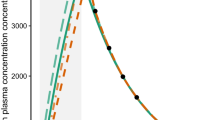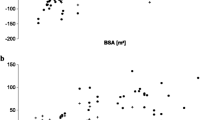Abstract
The traditional approach for model-based initial dosing is based on the use of a single vector of typical population parameters for targeting a specific exposure. This approach is theoretically ill-suited for targeting a range of exposure. The objective of this work was to develop a general approach for optimal (OPT) targeting of a drug exposure interval. After methodological purposes, we applied our method to the busulfan case. We used a nonparametric population pharmacokinetic model of intravenous busulfan to estimate the individual pharmacokinetic parameters of 163 bone marrow-transplanted children. Then, an array of 151 doses of busulfan ranging from 0.5 to 2 mg/kg was simulated a priori in each patient. For each dose, 29 possible busulfan plasma concentration profiles, corresponding to the nonparametric prior, each associated with a probability, were obtained. The multiple-model-based, OPT dose was identified as the dose maximizing the a priori probability of achieving the busulfan target area under the concentration-time curve (AUC). Two AUC targets were considered: 900–1500 (conventional) or <1500 µM min−1. Finally, the OPT dose was individually simulated in each patient. We compared the ability of this method to achieve the target exposure interval with that of three other traditional model-based methods and one based on the non-parametric approach. When targeting the busulfan conventional AUC range, the OPT dose provided better attainment than the best of the three other methods after one dose (82.2 vs. 41.7 %, p < 0.005), two doses (79.1 vs. 65.0 %, p < 0.005), and at the end of therapy (80.4 vs. 76.7 %, p < 0.42). The approach provided a balanced distribution between under- (10.4 %) and overexposure (9.2 %), while other approaches showed higher rates of underexposure (≥19 %). When targeting an AUC <1500 µM min, the OPT dose was successful in minimizing overexposure as 0 % of children showed simulated AUC >1500 µM min−1. Our approach has been designed to optimize the targeting of an exposure interval. When applied to busulfan in children, it outperformed the traditional model-based dosing approach, with earlier and better achievement of busulfan target AUC. The approach can be applied for OPT dosing of many drugs, when the target objective is an interval.



Similar content being viewed by others
References
Burton ME, Shaw LM, Schentag JJ, Evans WE. Applied pharmacokinetics and pharmacodynamics: principles of therapeutic drug monitoring. Baltimore: Lippincott Williams & Wilkins; 2006. p. 257–812.
Jelliffe RW, Schumitzky A, Bayard D, et al. Model-based, goal-oriented, individualised drug therapy: linkage of population modelling, new “multiple model” dosage design, Bayesian feedback and individualised target goals. Clin Pharmacokinet. 1998;34:57–77.
Holford NH. Target concentration intervention: beyond Y2K. Br J Clin Pharmacol. 2001;52(Suppl. 1):55S–9S.
Tod MM, Padoin C, Petitjean O. Individualising aminoglycoside dosage regimens after therapeutic drug monitoring: simple or complex pharmacokinetic methods? Clin Pharmacokinet. 2001;40:803–14.
Jelliffe R, Bayard D, Milman M, et al. Achieving target goals most precisely using nonparametric compartmental models and “multiple model” design of dosage regimens. Ther Drug Monit. 2000;22:346–53.
Katz D, D’Argenio DZ. Discrete approximation of multivariate densities with application to Bayesian estimation. Comput Stat Data Anal. 1984;2:27–36.
Katz D, D’Argenio DZ. Implementation and evaluation of control strategies for individualizing dosage regimens, with application to the aminoglycoside antibiotics. J Pharmacokinet Biopharm. 1986;14:523–37.
Sheiner LB, Beal S, Rosenberg B, Marathe VV. Forecasting individual pharmacokinetics. Clin Pharmacol Ther. 1979;26:294–305.
Rousseau A, Marquet P, Debord J, et al. Adaptive control methods for the dose individualisation of anticancer agents. Clin Pharmacokinet. 2000;38:315–53.
van Lent-Evers NA, Mathôt RA, Geus WP, et al. Impact of goal-oriented and model-based clinical pharmacokinetic dosing of aminoglycosides on clinical outcome: a cost-effectiveness analysis. Ther Drug Monit. 1999;21:63–73.
Le Meur Y, Büchler M, Thierry A, et al. Individualized mycophenolate mofetil dosing based on drug exposure significantly improves patient outcomes after renal transplantation. Am J Transplant. 2007;7:2496–503.
Evans WE, Relling MV, Rodman JH, et al. Conventional compared with individualized chemotherapy for childhood acute lymphoblastic leukemia. N Engl J Med. 1998;338:499–505.
McCune JS, Bemer MJ, Barrett JS, et al. Busulfan in infant to adult hematopoietic cell transplant recipients: a population pharmacokinetic model for initial and Bayesian dose personalization. Clin Cancer Res. 2014;20:754–63.
Paci A, Vassal G, Moshous D, et al. Pharmacokinetic behavior and appraisal of intravenous busulfan dosing in infants and older children: the results of a population pharmacokinetic study from a large pediatric cohort undergoing hematopoietic stem-cell transplantation. Ther Drug Monit. 2012;34:198–208.
Nguyen L, Fuller D, Lennon S, et al. I.V. busulfan in pediatrics: a novel dosing to improve safety/efficacy for hematopoietic progenitor cell transplantation recipients. Bone Marrow Transplant. 2004;33:979–87.
Long-Boyle JR, Savic R, Yan S, et al. Population pharmacokinetics of busulfan in pediatric and young adult patients undergoing hematopoietic cell transplant: a model-based dosing algorithm for personalized therapy and implementation into routine clinical use. Ther Drug Monit. 2015;37:236–45.
Zao JH, Schechter T, Liu WJ, et al. Performance of busulfan dosing guidelines for pediatric hematopoietic stem cell transplant conditioning. Biol Blood Marrow Transplant. 2015;21:1471–8.
Schumitzky A. Stochastic control of pharmacokinetic systems. In: Maronde RF, editor. Clin Pharmacol Ther. New York: Springer; 1986. p. 13–25. Available from: http://link.springer.com/chapter/10.1007/978-1-4612-4864-4_2. Accessed 15 Sept 2015.
D’Argenio DZ, Rodman JH. Targeting the systemic exposure of teniposide in the population and the individual using a stochastic therapeutic objective. J Pharmacokinet Biopharm. 1993;21:223–51.
Lindsay BG. The geometry of mixture likelihoods: a general theory. Ann Stat. 1983;11:86–94.
Mallet A. A maximum likelihood estimation method for random coefficient regression models. Biometrika. 1986;73:645–56.
Jelliffe R, Schumitzky A, Van Guilder M. Population pharmacokinetics/pharmacodynamics modeling: parametric and nonparametric methods. Ther Drug Monit. 2000;22:354–65.
Schumitzky A. Application of stochastic control theory to optimal design of dosage regimens. In: D’Argenio DZ, editor. Adv Methods Pharmacokinet Pharmacodyn Syst Anal. New York: Springer; 199. p. 137–52. Available from: http://link.springer.com/chapter/10.1007/978-1-4757-9021-4_13. Accessed 15 Sept 2015.
Tod M, Alet P, Lortholary O, Petitjean O. Implementation and evaluation of a stochastic control strategy for individualizing teicoplanin dosage regimen. J Pharmacokinet Biopharm. 1997;25:695–712.
Schumitzky A. Nonparametric EM algorithms for estimating prior distributions. Appl Math Comput. 1991;45:143–57.
Slattery JT, Sanders JE, Buckner CD, et al. Graft-rejection and toxicity following bone marrow transplantation in relation to busulfan pharmacokinetics. Bone Marrow Transplant. 1995;16:31–42.
Bolinger AM, Zangwill AB, Slattery JT, et al. Target dose adjustment of busulfan in pediatric patients undergoing bone marrow transplantation. Bone Marrow Transplant. 2001;28:1013–8.
McCune JS, Gooley T, Gibbs JP, et al. Busulfan concentration and graft rejection in pediatric patients undergoing hematopoietic stem cell transplantation. Bone Marrow Transplant. 2002;30:167–73.
Grochow LB, Jones RJ, Brundrett RB, et al. Pharmacokinetics of busulfan: correlation with veno-occlusive disease in patients undergoing bone marrow transplantation. Cancer Chemother Pharmacol. 1989;25:55–61.
Dix SP, Wingard JR, Mullins RE, et al. Association of busulfan area under the curve with veno-occlusive disease following BMT. Bone Marrow Transplant. 1996;17:225–30.
Cremers S, Schoemaker R, Bredius R, et al. Pharmacokinetics of intravenous busulfan in children prior to stem cell transplantation. Br J Clin Pharmacol. 2002;53:386–9.
Tran H, Petropoulos D, Worth L, et al. Pharmacokinetics and individualized dose adjustment of intravenous busulfan in children with advanced hematologic malignancies undergoing allogeneic stem cell transplantation. Biol Blood Marrow Transplant. 2004;10:805–12.
Vassal G, Michel G, Espérou H, et al. Prospective validation of a novel IV busulfan fixed dosing for paediatric patients to improve therapeutic AUC targeting without drug monitoring. Cancer Chemother Pharmacol. 2008;61:113–23.
Bleyzac N, Souillet G, Magron P, et al. Improved clinical outcome of paediatric bone marrow recipients using a test dose and Bayesian pharmacokinetic individualization of busulfan dosage regimens. Bone Marrow Transplant. 2001;28:743–51.
Philippe M, Goutelle S, Guitton J, et al. Should busulfan therapeutic range be narrowed in pediatrics? Experience from a large cohort of hematopoietic stem cell transplant children. Bone Marrow Transplant. 2015;51:72–8.
Bartelink I, Boelens JJ, Bredius RGM, et al. Body weight-dependent pharmacokinetics of busulfan in paediatric haematopoietic stem cell transplantation patients. Clin Pharmacokinet. 2012;51:331–45.
French Code of Public Health—Article L1121-1.
French Code of Public Health—Article L1121-2.
Neely M, Philippe M, Rushing T, et al. Accurately achieving target busulfan exposure in children and adolescents with very limited sampling and the BestDose software. Ther Drug Monit. 2016;38:332–42.
Neely MN, van Guilder MG, Yamada WM, et al. Accurate detection of outliers and subpopulations with Pmetrics, a nonparametric and parametric pharmacometric modeling and simulation package for R. Ther Drug Monit. 2012;34:467–76.
Neely M, Margol A, Fu X, et al. Achieving target voriconazole concentrations more accurately in children and adolescents. Antimicrob Agents Chemother. 2015;59:3090–7.
Neely M, Jelliffe R. Practical therapeutic drug management in HIV-infected patients: use of population pharmacokinetic models supplemented by individualized Bayesian dose optimization. J Clin Pharmacol. 2008;48:1081–91.
Bayard DS, Milman MH, Schumitzky A. Design of dosage regimens: a multiple model stochastic control approach. Int J Biomed Comput. 1994;36:103–15.
Rybak M, Lomaestro B, Rotschafer JC, et al. Therapeutic monitoring of vancomycin in adult patients: a consensus review of the American Society of Health-System Pharmacists, the Infectious Diseases Society of America, and the Society of Infectious Diseases Pharmacists. Am J Health Syst Pharm. 2009;66:82–98.
Gaillot J, Steimer JL, Mallet AJ, et al. A priori lithium dosage regimen using population characteristics of pharmacokinetic parameters. J Pharmacokinet Biopharm. 1979;7:579–628.
Gomeni R, Pineau G, Mentré F. Population kinetics and conditional assessment of the optimal dosage regimen using the P-PHARM software package. Anticancer Res. 1994;14:2321–6.
Dalle JH, Wall D, Theoret Y, et al. Intravenous busulfan for allogeneic hematopoietic stem cell transplantation in infants: clinical and pharmacokinetic results. Bone Marrow Transplant. 2003;32:647–51.
Malär R, Sjöö F, Rentsch K, et al. Therapeutic drug monitoring is essential for intravenous busulfan therapy in pediatric hematopoietic stem cell recipients. Pediatr Transplant. 2011;15:580–8.
Tesfaye H, Branova R, Klapkova E, et al. The importance of therapeutic drug monitoring (TDM) for parenteral busulfan dosing in conditioning regimen for hematopoietic stem cell transplantation (HSCT) in children. Ann Transplant. 2014;19:214–24.
Buffery PJ, Allen KM, Chin PKL, et al. Thirteen years’ experience of pharmacokinetic monitoring and dosing of busulfan: can the strategy be improved? Ther Drug Monit. 2014;36:86–92.
Wright DFB, Duffull SB. A Bayesian dose-individualization method for warfarin. Clin Pharmacokinet. 2013;52:59–68.
Traub SL, Johnson CE. Comparison of methods of estimating creatinine clearance in children. Am J Hosp Pharm. 1980;37:195–201.
Author information
Authors and Affiliations
Corresponding author
Ethics declarations
Funding
No sources of funding were used for this work. This work was not supported by any academic, company, or sponsor funds.
Conflict of interest
Michael Philippe, Yves Bertrand, Nathalie Bleyzac, and Sylvain Goutelle declare that they have no conflicts of interest. Michael Neely is partly supported by NIH-NIGMS R01 GM068968 and NIH-NICHD R01 HD070886.
Ethical approval
This was a non-interventional study without any additional procedure than those used in routine patient care. For these reasons, no institutional review board or ethics committee approval was required, in accordance with the French regulation on biomedical research.
Electronic supplementary material
Below is the link to the electronic supplementary material.
Rights and permissions
About this article
Cite this article
Philippe, M., Neely, M., Bertrand, Y. et al. A Nonparametric Method to Optimize Initial Drug Dosing and Attainment of a Target Exposure Interval: Concepts and Application to Busulfan in Pediatrics. Clin Pharmacokinet 56, 435–447 (2017). https://doi.org/10.1007/s40262-016-0448-6
Published:
Issue Date:
DOI: https://doi.org/10.1007/s40262-016-0448-6




